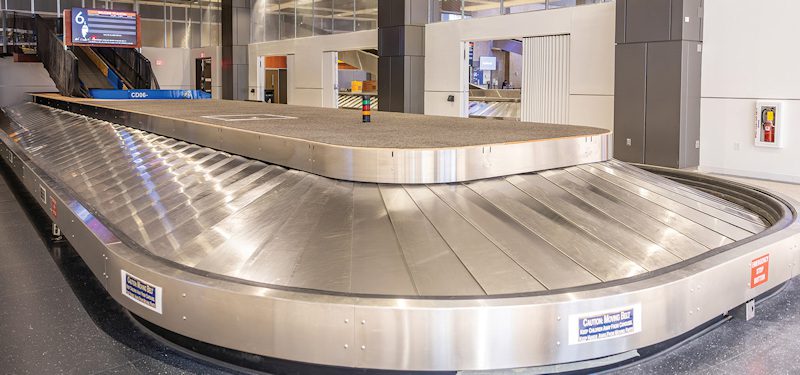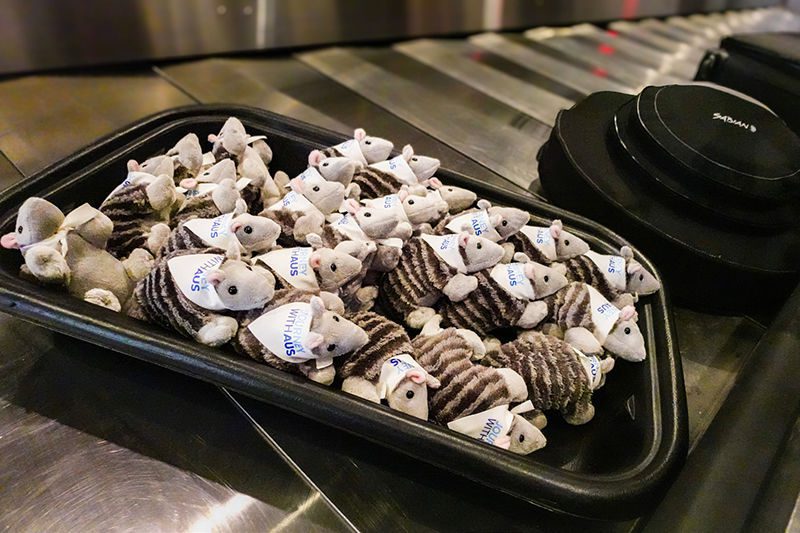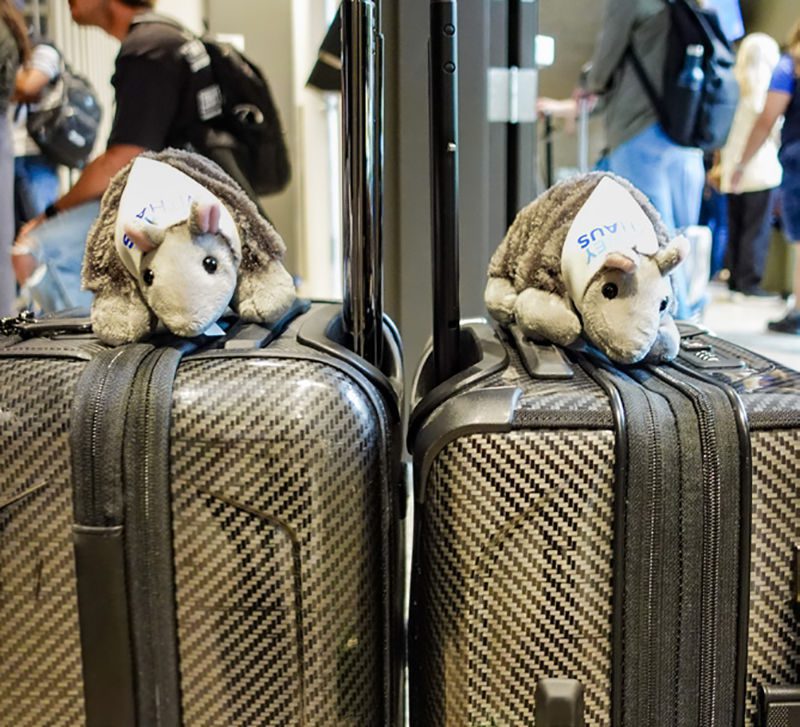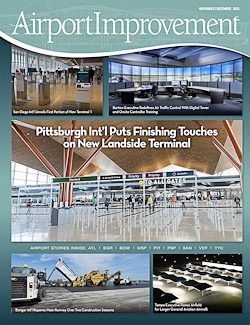Austin, TX, has been booming for the last couple of decades, with continued growth predicted into 2060. In turn, Austin-Bergstrom International Airport (AUS) is executing a plan to double its capacity to more than 30 million annual passengers by the early 2030s.
The airport achieved a major milestone toward that goal this summer when it finished a $13.8 million project to improve facilities for international arrivals in the Barbara Jordan Terminal. The results unveiled in June feature expanded baggage claim and passenger processing areas to increase capacity and reduce wait times for international travelers. One major element was adding two new Siemens baggage carousels that can flex to serve both international and domestic flights. An existing carousel was also reconfigured to accommodate oversized luggage of international passengers, and eliminates the need for time-consuming, labor-intensive manual handling.
The airport also worked closely with U.S. Customs and Border Protection to significantly upgrade its facilities and add more processing booths for greater efficiency. An expanded queuing and processing area gives arriving international passengers about 5,000 more square feet of elbow room.
| facts&figures
Project: Improving International Arrivals Facilities Location: Austin-Bergstrom Int’l Airport, in TX Major Components: 2 new baggage carousels, 1 reconfigured; expanded Customs queuing & processing areas Cost: $13.8 million Funding: Airport cash reserves; current & future airport revenues; future revenue bond proceeds; FAA grants Timeline: Initial discussions started in 2019; key contracts awarded in March 2024; project completed June 2025 (2 months ahead of schedule) Component of: Journey With AUS expansion program Architect/Designer: Gensler Building Envelope Consultant: Engineered Exteriors General Contractor: Whiting-Turner Baggage Handling Consultant: AECOM Structural Design: Structures Baggage Carousels: Siemens Key Benefits: Baggage claims can accommodate simultaneous international flights; carousels can flex between serving domestic & international flights; larger & enhanced international arrivals area; reduced wait times because passengers now clear Customs before claiming checked bags |
Overall, the project modified 20,600 square feet of space in the Barbara Jordan Terminal and is the first major step of Journey With AUS, the airport’s long-term multibillion-dollar expansion program. Plans, which are still evolving, include a new Arrivals and Departures Hall as long as 2½ football fields, and the addition of a midfield concourse that will add 20-plus gates and connect to the Barbara Jordan Terminal through an underground tunnel. In true AUS fashion, one of the guiding principles for the multi-decade development program is to continue offering passengers an authentic Austin and Central Texas experience.
“This project [the International Arrivals Improvements project] is a defining example of how we’re shaping the future of air travel in Austin,” said AUS Chief Executive Officer Ghizlane Badawi in a June press release. “The enhancements to our international arrivals experience significantly improve efficiency and comfort for passengers today, while laying the foundation for a more globally connected and passenger-focused airport of tomorrow. It’s just the beginning of what the Journey With AUS expansion program will deliver for our community, our passengers, our partners and our stakeholders.”
Maintaining Service
Rohini Kumarage, who was promoted from project manager to implementation officer during the International Arrivals Improvements project, served as the primary hands-on project manager for the first main component of Journey With AUS program. Moving forward, she will manage other project managers more than the projects themselves.
Kumarage emphasizes that the airport still had to accommodate international and domestic arrivals while crews executed improvements in the baggage claim area. “The airlines were very concerned that the construction would impact their domestic travelers, and they wanted to know how many baggage claims we were going to shut down,” she recalls. “We made the commitment that at any given time, we would not shut down more than one bag claim at a time.”
Crews installed one of the new carousels before removing a smaller existing unit that was no longer meeting the airport’s needs. During that process, AUS staff transferred domestic bags to other baggage claim areas to make sure that airlines could accommodate both domestic and international passengers without any hiccups.
Timing was tricky with up to 11 international flights arriving at AUS daily—some no more than one hour apart. Previously, backups in baggage handling occurred if international flights overlapped due to delays. With only one baggage carousel, the airport could not mix the incoming baggage from international flights. Staff had to wait until all bags from one flight were removed from the carousel before loading bags from the next flight.
“Now we don’t have that issue because we have multiple baggage claim carousels,” Kumarage says.
The airport also changed the order of operations, so to speak, for arriving international passengers. Previously, they were required to pick up their checked bags first and then proceed to Customs. Now, incoming travelers clear Customs first, and then pick up their bags.
Badawi reports that passengers appreciate this change, because the process is now faster. “Because they get processed by CBP [Customs and Border Protection] first, their bags are already there by the time they come to the carousel,” she explains.
Now, if a British Airways flight arrives at the same time as a KLM flight, passengers have more room to line up in the expanded Customs facility, and they can be routed to separate bag claims without delay.
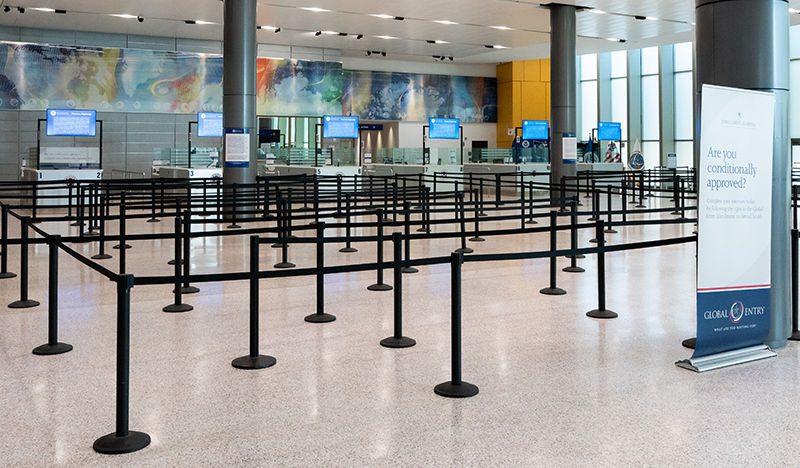
The Customs area now has more queuing space and processing booths.
 “The airport faced a unique challenge: finding a way to accommodate both domestic and international passenger traffic in the same space at different times for baggage claim,” explains Kumarage. “Working with AECOM as the baggage handling subject matter expert, we evaluated the facility capacity based on flight arrival curves and developed a ‘swing claim hall’ solution, the first of its kind in the U.S. This innovative approach enhances flexibility, maximizes efficiency and improves the experience for arriving AUS travelers.”
“The airport faced a unique challenge: finding a way to accommodate both domestic and international passenger traffic in the same space at different times for baggage claim,” explains Kumarage. “Working with AECOM as the baggage handling subject matter expert, we evaluated the facility capacity based on flight arrival curves and developed a ‘swing claim hall’ solution, the first of its kind in the U.S. This innovative approach enhances flexibility, maximizes efficiency and improves the experience for arriving AUS travelers.”
Local Support
Whiting-Turner and Siemens, with AECOM’s recommendation, led the charge and tasked Gensler, the architect for Whiting-Turner, with preparing design drawings and specifications. Gensler joined the project with more than three decades of experience at AUS, and, in fact, was part of the joint venture that designed the 660,000-square-foot Barbara Jordan terminal 25 years ago. It also designed Austin’s tallest downtown-skyscraper.
“We worked on the nine-gate expansion, the West infill project and the international arrivals area, so we feel very invested in Austin and in Austin’s airport,” says Gensler Project Manager Adrienne Perlman. “We’re really proud to have a center of excellence for aviation here in Austin.”
Perlman says she appreciates that AUS opted to use a design-build delivery method for its International Arrivals Improvements project. “With a construction manager at risk project, it’s a typical design-bid-build process,” she explains. “The design team writes up all the documents, works with the owner to get what they need; then the owner puts it out for bid and selects a contractor, usually at the lowest price.”
 The owner enters into one contract with the architect and another separate agreement with the contractor. However, the contractor and architect don’t have any kind of contractual connection with each other. In that type of relationship, the two companies are inherently at odds, says Perlman.
The owner enters into one contract with the architect and another separate agreement with the contractor. However, the contractor and architect don’t have any kind of contractual connection with each other. In that type of relationship, the two companies are inherently at odds, says Perlman.
“In a design-build situation, we’re all one team and we can all work together and deliver everything together instead of fighting against each other,” she contrasts. “Working with Whiting-Turner [the general contractor] has been a real joy and a pleasure. They understand aviation architecture, they understand the clients, they understand the city of Austin, and we worked fabulously together to deliver this project.”
Case in point: The firms finished the $13.8 million project on budget and two months ahead of schedule.
Kumarage extends the cooperative spirit of AUS’ recent design-build experience to her industry peers. “Every airport has challenges, but if we sit down and work as a team and come up with ideas, there are ways that we can overcome these challenges,” she reflects. “If other airports have similar challenges, we are more than happy to sit and talk with them about this project.”
Coming Home to AUS
With improvements in place to reduce wait times for arriving international travelers, it’s clear to airport officials that more development is needed to accommodate future growth. Design of a larger arrivals and departures hall to expand capacity even more is currently in progress with SOM (Skidmore, Owings & Merrill)—just one of many projects in the works. Journey With AUS will touch practically every part of the airport in some way, from new midfield taxiways on the airfield to renovated restrooms along the concourses.
“Austin is a city that’s not dying; it’s a city that’s growing,” Perlman says. “That growth—even though a lot of us who have been here for a long time might grumble about it—is a good thing. It keeps us fresh, and it keeps everything happening around us. That’s what makes Austin special, and the airport itself has tapped into that spirit.”
She emphasizes that it’s important for local passengers returning from trips to feel at home in the airport. “It has a distinctive Austin, Texas, flavor that is unique to anywhere else in the world,” she says. “When I come home from an international trip, I feel like I’m welcomed into the city of Austin. As soon as I get off the plane, I see evidence of Austin all around me.”
| Who Doesn’t Love a Good ’Dillo Drop?
On May 19, passengers waiting for their checked luggage at Austin-Bergstrom International Airport (AUS) were surprised and delighted when a bin brimming with stuffed armadillos slid onto the carousel at Baggage Claim 6. The airport was giving away plush versions of “Armie the Armadillo,” the mascot for its long-term expansion and development program, and guests buzzed with excitement.
The so-called ’Dillo Drop was staged to highlight three new baggage carousels added during the International Arrivals Improvements project. To stoke interest, the airport’s social media team sent out a somewhat cryptic warning about an “armadillo infestation” in the Baggage Claim area just before the bin of giveaways began circling on the new carousel. Staff members were also on hand to explain who Armie is and record video of the scene to promote it afterward on Facebook, Instagram, X, LinkedIn and YouTube. The event even garnered local news coverage.
Follow-up posts from the airport encouraged travelers to watch for other ’Dillo Drops throughout the summer. As of early September, there had already been two. Just three days before the successful giveaway, AUS made another clever announcement on social media. This time, it promoted the expansion of its Customs processing area by noting that international passengers would soon have 5,000 more square feet for queuing—enough space for 103,000 tacos. |

